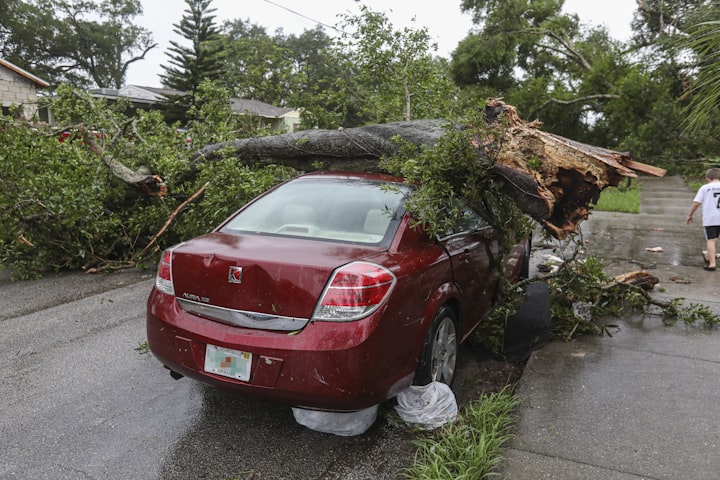Hurricane Idalia
Storm that Pummeled Florida and the Carolinas

Quick Note from Me
I live in southeastern Georgia, and this hurricane even left us without power for two days. Some places here in GA still don't have power. That was just from the wind damage mostly. Those hit directly experienced a hell that can't really be put into words. Our hearts go out to them.
Hurricane Idalia was a powerful and destructive storm that made landfall in Florida on August 30, 2023. The storm was a Category 3 hurricane with maximum sustained winds of 125 mph. It brought torrential rains, strong winds, and storm surge to the Florida Panhandle and the Carolinas.
Idalia formed in the Gulf of Mexico on August 27. It quickly strengthened and became a hurricane on August 29. The storm then tracked north-northwest, making landfall in Florida near Keaton Beach at 11:45 AM EDT on August 30.
The storm surge from Idalia was particularly destructive. It reached up to 12 feet in some areas of the Florida Panhandle. This caused widespread flooding and damage to homes and businesses. The strong winds from Idalia also caused power outages and downed trees.
Idalia continued to track north-northwest after landfall. It made landfall again in South Carolina on September 1 as a Category 2 hurricane. The storm then weakened and became a tropical storm as it moved into North Carolina.
Idalia caused widespread damage in Florida, the Carolinas, and Georgia. The storm is estimated to have caused at least $10 billion in damage. There were also three fatalities attributed to the storm.
How Hurricanes Form
Hurricanes form over warm tropical waters. The water temperature needs to be at least 80 degrees Fahrenheit for a hurricane to form. The warm water provides the energy for the storm to grow.
Hurricanes also need a lot of moisture in the atmosphere. The moisture helps to create the clouds and rain that are associated with hurricanes.
When these conditions are met, a tropical disturbance can develop. A tropical disturbance is a low-pressure system that has some of the characteristics of a hurricane, but it is not yet strong enough to be classified as a hurricane.
If the tropical disturbance continues to grow and strengthen, it will eventually become a hurricane. Hurricanes are classified by their maximum sustained winds. The Saffir-Simpson Hurricane Wind Scale has five categories, with Category 5 being the strongest.
Tips for Staying Safe During a Hurricane
- Make sure you have a plan in place. This should include knowing where you will go if you need to evacuate, and having a list of essential supplies.
- Listen to local news and weather reports for updates on the storm.
- If you are told to evacuate, do so immediately.
- Stay away from flooded areas.
- If you must drive, use caution and be aware of downed power lines and other hazards.
Hurricane Idalia was a devastating storm that caused widespread damage and loss of life. However, the recovery is ongoing, and the affected communities will rebuild.
5 Deadliest Hurricanes in History
- Great Galveston Hurricane (1900): This Category 4 hurricane made landfall on September 8, 1900, in Galveston, Texas. It is estimated to have killed between 8,000 and 12,000 people, making it the deadliest natural disaster in U.S. history. The storm surge from the hurricane was over 15 feet high, and it completely destroyed the city of Galveston.
- Okeechobee Hurricane (1928): This Category 4 hurricane made landfall on September 16, 1928, in Lake Okeechobee, Florida. It is estimated to have killed between 2,500 and 3,000 people, mostly from flooding. The hurricane caused the dike around Lake Okeechobee to break, and the resulting floodwaters killed thousands of people.
- Katrina (2005): This Category 3 hurricane made landfall on August 29, 2005, in New Orleans, Louisiana. It is estimated to have killed between 1,800 and 1,833 people, and caused an estimated $108 billion in damage. Katrina was the costliest hurricane in U.S. history, and it caused widespread flooding in New Orleans and the surrounding area.
- Cheniere Caminada Hurricane (1893): This Category 4 hurricane made landfall on October 1, 1893, in Cheniere Caminada, Louisiana. It is estimated to have killed between 2,000 and 2,500 people. The hurricane caused widespread damage in Louisiana and Mississippi, and it is considered to be one of the deadliest hurricanes to hit the Gulf Coast.
- Mitch (1998): This Category 5 hurricane made landfall on October 29, 1998, in Honduras. It is estimated to have killed between 9,086 and 11,000 people, mostly in Honduras and Nicaragua. Mitch caused widespread flooding and mudslides in Central America, and it is considered to be one of the deadliest hurricanes in the Atlantic basin.
About the Creator
Timothy A Rowland
I’m an every day human Xennial from the United States. I have many interest. I just want to improve your life and maybe entertain you. Available for editing and LeadsLeap projects at: https://www.fiverr.com/greyhatcompany






Comments
There are no comments for this story
Be the first to respond and start the conversation.